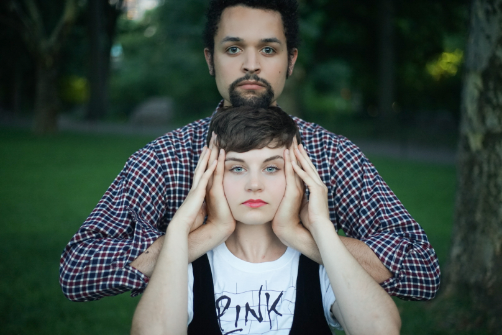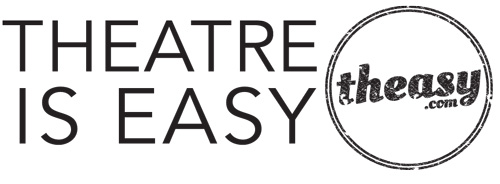The Great Brown Bear
Written and Directed by Kierna Conner; Choreographed by Josh Dunn and Alex Doyle
Produced by Crokimo Productions
Part of the 2018 New York International Fringe Festival
Off Off Broadway, Storytelling and Dance
Runs through 10.16.18
FringeHUB, 685 Washington Street
by Ran Xia on 10.16.18
 Christopher Okawa and Kierna Conner in The Great Brown Bear. Photo by Casey Martin Klein.
Christopher Okawa and Kierna Conner in The Great Brown Bear. Photo by Casey Martin Klein.
BOTTOM LINE: Distilled from a Scandinavian folk tale, Crokimo Productions' The Great Brown Bear is a poetic exposition on the myth of love and the anatomy of marriage.
The story goes like this: a beautiful princess falls in love with a great brown bear. The princess is at first rewarded for her curiosity, for underneath the façade of a brutish bear is a handsome prince in disguise, enchanted by an evil witch. But then the curious princess is punished for her attempt to discover what's underneath her husband's tough exterior. It drives them apart, and it falls on her to save the relationship. The persistent princess sets out to reclaim her one true love, sloshing through snowy mountains, following the advice of the east wind... and then, and then. Most versions of the story end with this: "And they lived happily ever after".
But what comes after “happily ever after?” Romance turns into habit, and the man and the woman soon become one another’s prison. The man starts to take the woman for granted, while the woman starts to realize that she’s losing her individuality. The man encourages the woman to pick up her long-lost of dream of painting, but what he discovers from her art scares him. They gradually realize, like the princess in the story, that there is more to the other person than what meets the eye.
The story is a familiar one. Even if you've never heard of "East o' the Sun, West o' the Moon," the Norwegian tale from which this show takes its inspiration, the plot largely resembles that of The Snow Queen, or even Beauty and the Beast. This earnest and poetic production doesn't necessarily attempt to elucidate all of the metaphors, but rather, present their own interpretation in juxtaposition to the original folktale, and give the audience room for imagination.
The Great Brown Bear's ensemble cast performs its archetypal characters in rotation. All the women step into the role of the princess and the wife; and all the men become the bear, as well as the husband. The four main characters are identified by a unique costume piece: a paper crown for the princess, a mask for the bear, an ornate headband for the wife, and a leather jacket for the husband. Through this deliberate attempt to erase the “faces” of the characters, the production effectively emphasizes how stories are inherited through generations, and passed across cultures. However, I wish the convention would’ve been made clearer in the beginning, as the costume pieces are somewhat too subtle.
The strength of the piece lies in its adamant belief in using simply human voices, physical movements, and mostly practical effects to give its audience an immersive experience within a minimal set. With a few flashlights, a sprinkle of leaves, and the teams’ artisanal craftsmanship, the non-traditional space (it takes place in what looks like a painting studio) is effortlessly transformed into an imaginary realm. One of my favorite moments in the piece is the kitchen table symphony of the wife: performer Alexander Doyle delivers an astounding soloist number, accompanied by percussive music composed using solely kitchen and dining room utensils as instruments. It perfectly illustrates the way we perceive everything around us and the effects love has on it. When does the act of cooking turn from a celebration of intimacy, to a chore? And what makes a woman go from hearing the most beautiful music from plates clinking and clanking, to loathing the way her husband chews? Is marriage the end of romance?
It is clear that every moment of The Great Brown Bear comes from an honest place within the inventive team of performers and creators. There are sections in this ninety-minute piece that linger more than necessary, and the multitude of poetic styles can be overwhelming. The vocal arrangements and elaborate choreography are beautiful, yet sometimes drown each other out. The audience interaction elements feel a bit gratuitous rather than helpful in terms of illuminating the narrative. Despite its flaws, The Great Brown Bear has an abundance of raw creative intuition, ingenious execution of ideas with minimal props and sets, and endless potential. Moreover, the show has the capacity to travel, and be unfolded anywhere. I wouldn’t be surprised if the piece takes off to achieve more success beyond the Fringe.
(The Great Brown Bear plays at FringeHUB, 685 Washington Street at Charles Street, through October 16, 2018. Meet at the RED FringeNYC flag. The running time is 1 hour 30 minutes. Performances are Fri 10/12 at 5:45, Sat 10/13 at 2:45, Sun 10/14 at 7:45, Mon 10/15 at 5, and Tue 10/16 at 8. There is no late seating at FringeNYC. Tickets are $22 (plus $3.69 ticketing fee), $16 (plus $3.51) for seniors, and are ONLY available online at fringenyc.org. For more information visit thegreatbrownbear.com.)
The Great Brown Bear is written and directed by Kierna Conner, based on the classic Scandinavian folk tale "East o’ the Sun, West o’ the Moon." Choreographed by Josh Dunn and Alex Doyle. Set Design by Jeanne Torres. Costume Design by Kierna Conner. Stage Manager is Kara O'Connor.
The cast is Kierna Conner, Jamie Dillon, Alexandra Doyle, Caleb Marshall, Chris Okawa, Nick Picknally, Jared Sigler, Sarah Sinizer-Hopkins, and Chance Wall.

